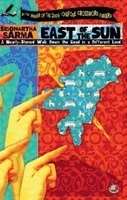
Siddhartha Sarma’s
East of the Sun reminded me of something I had almost forgotten. The pleasure of being a journalist and the joy of encountering something that urgently warrants a stream-of-consciousness piece.
East of the Sun is about an itch to travel..an itch that loops itself around the brain like an ushakeable song. It is about the lure of the “particular narrowness of the narrow road” that sees the author traversing the Bramhaputra valley, East Assam, Naga hills, Kohima, Imphal Valley, Manipur and Myanmar. A journey through a region that as he says is an idea, a garland with some common history, some common languages, religions and ethnicity running all through it.
A region that defies easy summation. A region of colliding stimuli, glimpses of a giant, golden river, the taste of real momos and suspicious tasting morsels of meat and the thrill of discovering places and people who do not get bandwidth and playtime in national consciousness.
Sidhartha’s journey is personal but not sentimental..it does not blatantly plunge you headlong in the politics of the region. It instead tells you what it is to travel without preconceptions through a region loaded with political subtext and more importantly human stories, vast varieties of trees, people, rivers and forests and mineral reserves, shared and divided history.
You can hear the choirs and the rock bands running through the veins, hills and valleys of the North East. It is all there.
Myth and mythology, architectural details, thrumming bazaars, tea estates, oil wells, mists, memories of bullets flying across tennis courts, fat dragons, bhut jholakiya, a seedy hotel, cathedrals and cemetries, ribbony roads, orchids, monasteries, good resturants, crappy restaurants, road blocks, mudslides and long walks in the rain, angry mobs and close calls, famines and flowering bamboo forests, greedy rats, terraced fields of pineapples and oranges, waterfalls, lakes, archaeological digs, quakes and floods and storm drains, omega collisions of hills and ideologies, infrastructure that brutally clears up the past to make way for the future.
Yes, the book has it all. What it does not have are cliches. The author has issues with stereotyping the North-East as a troubled egion. As he says, “That’s old story. That is what happens when someone recycles the same overused phrases because there are no fresh updates, no fresh adjectives.”
Or when he says,”From a distance, reading the land in a newspaper, you get all sorts of notions. Just don’t trust everything that the papers tell you. They don’t give you the usual, the ordinary, the commonplace, the normal.”
So when we land in Sidhartha’s memoryscape, the weather looks just fine. And there is much to see and to read. And to remember.
Siddhartha Sarma is a journalist based in Delhi, and an author. His debut novel The Grasshopper’s Run, and a non-fiction book, 103 Journeys, Travels, Trips and Stuff, were shortlisted for the 2009 Crossword Children’s Book Award. The first won it. He is also an occasional budget-traveller, and is known for exaggerating his experiences and drinking much tea on the road.
 Siddhartha Sarma’s East of the Sun reminded me of something I had almost forgotten. The pleasure of being a journalist and the joy of encountering something that urgently warrants a stream-of-consciousness piece.
Siddhartha Sarma’s East of the Sun reminded me of something I had almost forgotten. The pleasure of being a journalist and the joy of encountering something that urgently warrants a stream-of-consciousness piece. Siddhartha Sarma’s East of the Sun reminded me of something I had almost forgotten. The pleasure of being a journalist and the joy of encountering something that urgently warrants a stream-of-consciousness piece.
Siddhartha Sarma’s East of the Sun reminded me of something I had almost forgotten. The pleasure of being a journalist and the joy of encountering something that urgently warrants a stream-of-consciousness piece.





Stream of consciousness travel writing! this is the first book I will buy when I get back to India!